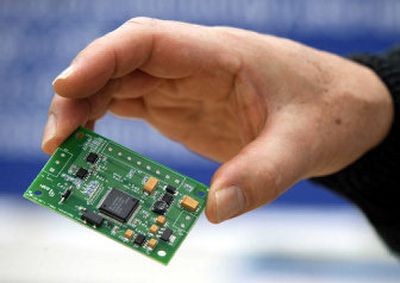Smart appliances to tune in to the grid

RICHLAND – It happens all the time. A tree falls on a major electrical line. Or a power plant unexpectedly goes off-line.
Those everyday blips in the nation’s power supply can leave the power grid vulnerable to demanding consumers who expect to be able to flip a light switch at any time.
But what if your appliances could sense the stress and reduce their power usage to help stabilize the system? Imagine a dryer that turns off its heating unit for a few minutes to momentarily conserve power, while still tumbling your clothes to avoid wrinkles. Or a refrigerator smart enough to know when – and when not – to defrost the freezer.
Researchers who have been working to develop just such appliances are ready to roll out a pilot project testing their usage and consumers’ reaction in a few select Northwest communities.
“It’s not about saving power overall, but saving power when you most need it – at times of high pressure on the power grid,” said Robert Pratt, a staff scientist at the Pacific Northwest National Laboratory, a U.S. Department of Energy Laboratory operated by Battelle.
Pratt likened the technology to “shock absorbers” for the electrical grid.
“You can still keep the lights on – cheaper and better – if you build in some shocks,” Pratt said. “We want to show there are no hiccups with the technology. But we’re also trying to show that nobody notices if the heating element on their dryer is shut off for 5 minutes.”
For several years, researchers at the lab have been developing a circuit board that, when inserted into appliances, could monitor the frequency of the power grid through the electrical outlet. Now, those researchers are testing the project by issuing free dryers to dozens of consumers with high-speed Internet access in several Northwest cities: Yakima, Shelton, Sequim and Port Angeles in Washington state, as well as Gresham, Ore. Some residents also will receive similar monitors for their water heaters.
The pilot project was made possible by $1.5 million from the Energy Department.
The idea of appliances talking to the grid and vice versa is a new dimension in the power industry that is just beginning to take off, said Steve Hauser, executive director of the GridWise Alliance, a Washington, D.C.-based industry association of about 20 member companies and utilities.
In its second year, the group has been pushing for more grid-friendly technology.
“Right now, the real flexibility in meeting future demands in the power system is on better management of the demand side. Basically, we’ve not done a very good job of that,” said Hauser, who previously worked at the laboratory.
Demand for electricity has increased about 1.7 percent each year, but the nation’s utilities have boosted power supply by only about 0.5 percent each year, said Clark Gellings, vice president of innovation for the Electric Power Research Institute in Palo Alto, Calif., a research and development collaborative sponsored by the country’s electric utilities.
Meanwhile, inflation-adjusted investment in the nation’s transmission system is at its lowest point since the Depression.
“That’s a formula for failure somewhere along the line,” Gellings said. New technologies, such as the grid-friendly appliances, could reduce the need for some of those upgrades in both transmission and distribution, he said.
Transmission is a key concern for PacifiCorp, a Portland utility that serves six Western states. The utility has been helping the lab find residents to participate in the project.
“Most consumers don’t understand how the power grid works. They have a vague notion that it carries bulk power from somewhere else to their region and are confident that as long as it works OK, they are serviced by it,” said Dave Kvamme, PacifiCorp spokesman. “In reality, the operation of the grid is very complex, and if we have one more tool in keeping the grid stable and acting more effectively, we have taken another step toward improving service.”